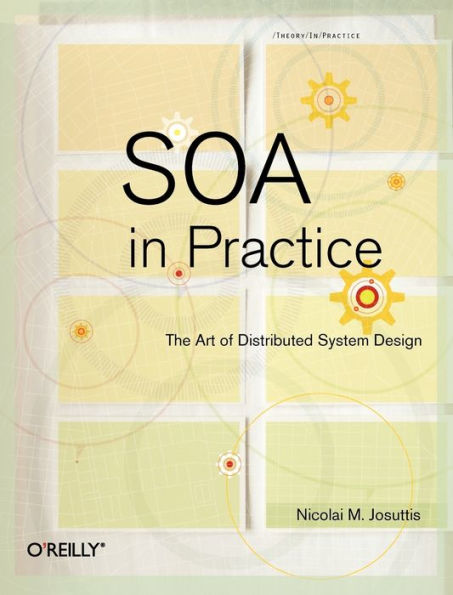SOA in Practice: The Art of Distributed System Design
This book demonstrates service-oriented architecture (SOA) as a concrete discipline rather than a hopeful collection of cloud charts. Built upon the author's firsthand experience rolling out a SOA at a major corporation, SOA in Practice explains how SOA can simplify the creation and maintenance of large-scale applications. Whether your project involves a large set of Web Services-based components, or connects legacy applications to modern business processes, this book clarifies how — and whether — SOA fits your needs.
SOA has been a vision for years. This book brings it down to earth by describing the real-world problems of implementing and running a SOA in practice. After defining SOA's many facets, examining typical use patterns, and exploring how loose coupling helps build stronger applications, SOA in Practice presents a framework to help you determine when to take advantage of SOA. In this book you will:
—Dr. Steffen Roehn, Member of the Executive Committee T-Mobile International (CIO)
"Nicolai Josuttis has produced something that is rare in the over-hyped world of SOA; a thoughtful work with deep insights based on hands-on experiences. This book is a significant milestone in promoting practical disciplines for all SOA practitioners."
—John Schmidt, Chairman, Integration Consortium
"The book belongs in the hands of every CIO, IT Director and IT planning manager."
—Dr. Richard Mark Soley, Chairman and CEO, Object Management Group; Executive Director, SOA Consortium
1101818658
SOA has been a vision for years. This book brings it down to earth by describing the real-world problems of implementing and running a SOA in practice. After defining SOA's many facets, examining typical use patterns, and exploring how loose coupling helps build stronger applications, SOA in Practice presents a framework to help you determine when to take advantage of SOA. In this book you will:
- Focus squarely on real deployment and technology, not just standards maps
- Examine business problems to determine which ones fit a SOA approach before plastering a SOA solution on top of them
- Find clear paths for building solutions without getting trapped in the mire of changing web services details
- Gain the experience of a systems analyst intimately involved with SOA
—Dr. Steffen Roehn, Member of the Executive Committee T-Mobile International (CIO)
"Nicolai Josuttis has produced something that is rare in the over-hyped world of SOA; a thoughtful work with deep insights based on hands-on experiences. This book is a significant milestone in promoting practical disciplines for all SOA practitioners."
—John Schmidt, Chairman, Integration Consortium
"The book belongs in the hands of every CIO, IT Director and IT planning manager."
—Dr. Richard Mark Soley, Chairman and CEO, Object Management Group; Executive Director, SOA Consortium
SOA in Practice: The Art of Distributed System Design
This book demonstrates service-oriented architecture (SOA) as a concrete discipline rather than a hopeful collection of cloud charts. Built upon the author's firsthand experience rolling out a SOA at a major corporation, SOA in Practice explains how SOA can simplify the creation and maintenance of large-scale applications. Whether your project involves a large set of Web Services-based components, or connects legacy applications to modern business processes, this book clarifies how — and whether — SOA fits your needs.
SOA has been a vision for years. This book brings it down to earth by describing the real-world problems of implementing and running a SOA in practice. After defining SOA's many facets, examining typical use patterns, and exploring how loose coupling helps build stronger applications, SOA in Practice presents a framework to help you determine when to take advantage of SOA. In this book you will:
—Dr. Steffen Roehn, Member of the Executive Committee T-Mobile International (CIO)
"Nicolai Josuttis has produced something that is rare in the over-hyped world of SOA; a thoughtful work with deep insights based on hands-on experiences. This book is a significant milestone in promoting practical disciplines for all SOA practitioners."
—John Schmidt, Chairman, Integration Consortium
"The book belongs in the hands of every CIO, IT Director and IT planning manager."
—Dr. Richard Mark Soley, Chairman and CEO, Object Management Group; Executive Director, SOA Consortium
SOA has been a vision for years. This book brings it down to earth by describing the real-world problems of implementing and running a SOA in practice. After defining SOA's many facets, examining typical use patterns, and exploring how loose coupling helps build stronger applications, SOA in Practice presents a framework to help you determine when to take advantage of SOA. In this book you will:
- Focus squarely on real deployment and technology, not just standards maps
- Examine business problems to determine which ones fit a SOA approach before plastering a SOA solution on top of them
- Find clear paths for building solutions without getting trapped in the mire of changing web services details
- Gain the experience of a systems analyst intimately involved with SOA
—Dr. Steffen Roehn, Member of the Executive Committee T-Mobile International (CIO)
"Nicolai Josuttis has produced something that is rare in the over-hyped world of SOA; a thoughtful work with deep insights based on hands-on experiences. This book is a significant milestone in promoting practical disciplines for all SOA practitioners."
—John Schmidt, Chairman, Integration Consortium
"The book belongs in the hands of every CIO, IT Director and IT planning manager."
—Dr. Richard Mark Soley, Chairman and CEO, Object Management Group; Executive Director, SOA Consortium
39.99
In Stock
5
1

SOA in Practice: The Art of Distributed System Design
342
SOA in Practice: The Art of Distributed System Design
342
39.99
In Stock

Product Details
| ISBN-13: | 9780596529550 |
|---|---|
| Publisher: | O'Reilly Media, Incorporated |
| Publication date: | 08/31/2007 |
| Pages: | 342 |
| Product dimensions: | 7.00(w) x 9.19(h) x 0.80(d) |
About the Author
From the B&N Reads Blog
